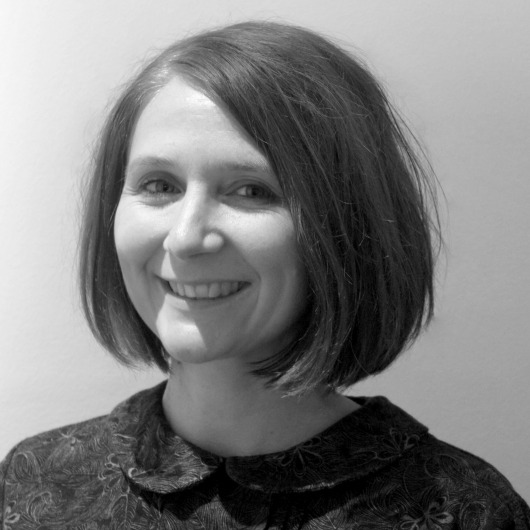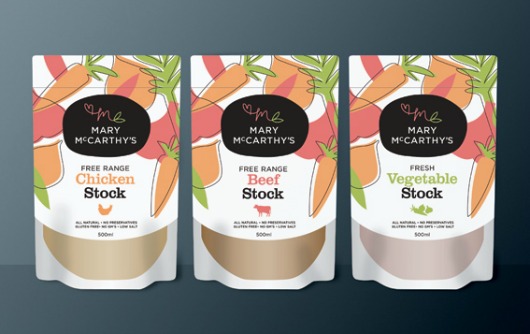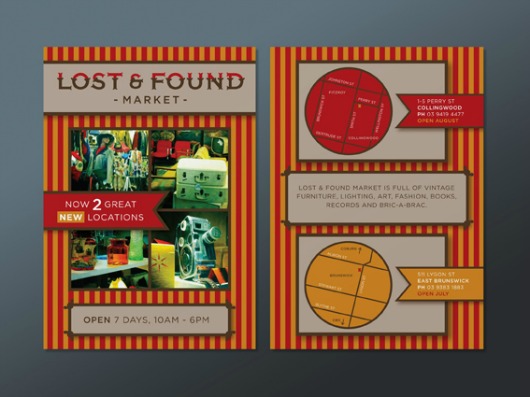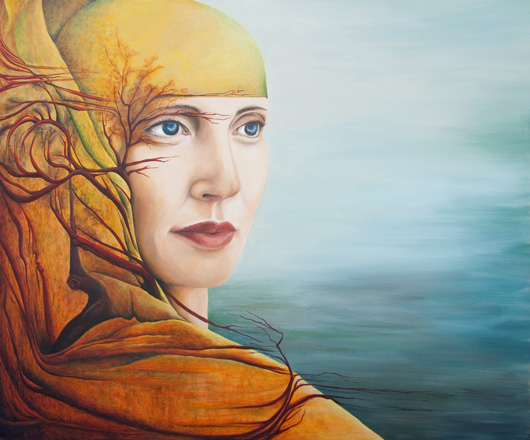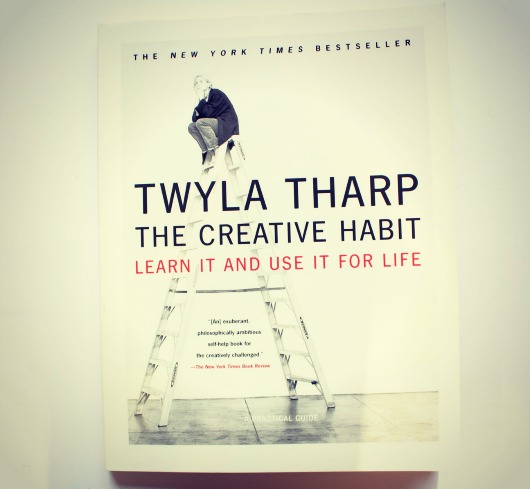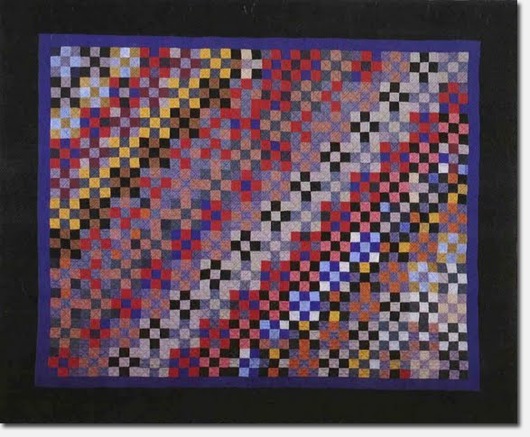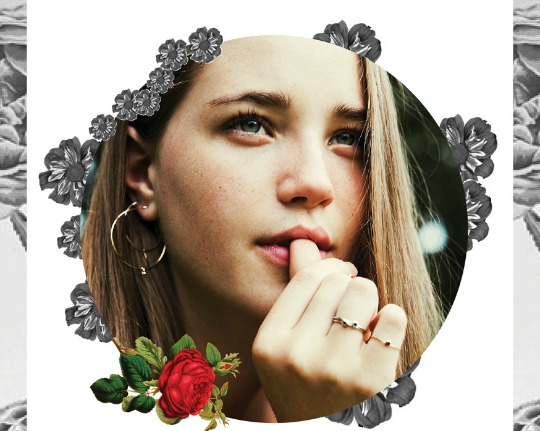Eco-Friendly Creative Practice: Jules Clancy
By Phoebe Miller Food, glorious food. For what is really a simple, basic human need, it's a complex topic these days, not least of all when it comes to addressing sustainability. What we eat and how source, prepare and eat it can have a huge environmental impacts.
I don't know about you, but the plethora of information and choices surrounding these issues can be overwhelming, especially at 6pm when all really want to do is work out what's for dinner! However, sometimes taking small, simple measures are all you need to get started on the right track. Sydney-based food lover and blogger, Jules Clancy, has set out to show us just how easy it can be to cook quick meals that are healthy, sustainable and affordable!
 A big pot of beans, via Stonesoup
A big pot of beans, via Stonesoup
What do you do? I blog about delicious healthy meals in minutes over at www.thestonesoup.com. I also teach people from all over the world the art of simple, healthy cooking on my online cooking school.
How do you approach sustainability and environmental awareness in your creative practice? For me it’s all about sourcing sustainable ingredients from producers who care about food. I’m also experimenting with my own small veggie garden.
 Sprout & Pumpkin Salad, via Stonesoup
Sprout & Pumpkin Salad, via Stonesoup
Can you tell me about one or two of your favourite projects that showcase this approach best? I ran a class last year called ‘Mastering the Art of Cooking on a Budget’. Basically I documented myself feeding myself for a week on $5 a day using minimal processed food. The class was ‘pay what you can afford’ and I got an awesome response from my students who had discovered that healthy food doesn’t need to take a lot of time or skill, nor does it necessarily have to be expensive.
What challenges have you come up against in trying to make your work more sustainable and how did you overcome them? The biggest challenge for me is figuring out which options truly are the best from a sustainability perspective. If something is organic but has been shipped from further away is it better or worse than locally produced conventional produce?
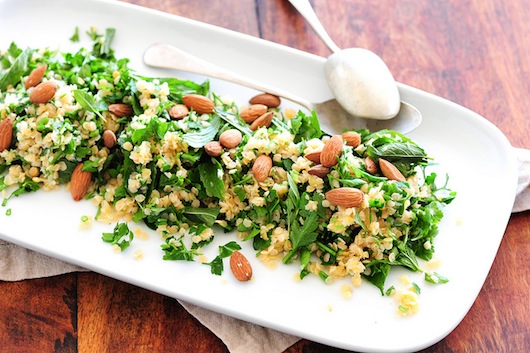 Lentil Tabbouleh, via Stonesoup
Lentil Tabbouleh, via Stonesoup
Is there anything you’d like to do or learn to further increase the environmental sustainability of your work? I’d love to learn more about sustainable seafood... which species are best for the environment and for our bodies.
Who are the other creative women doing new or interesting things with a focus on environmental sustainability that you admire or are inspired by? Tough one. I love what Alice Waters in the US and Stephanie Alexander in Australia have done with introducing ‘edible playground’ and ‘kitchen garden’ programs into schools to educate children about where food comes from and how to prepare delicious healthy food.
Phoebe Miller is a Brisbane-bred, Sydney-fled, Melbourne-embedded gal who enjoys making, spruiking, collecting, and exploring. After several years working in corporate marketing and communications, Phoebe followed the urge to explore her creative side. These days she divides her time between her sustainable fashion accessories label, Simply Phoebe, and freelance PR consulting.
CWC Member Feature : Stephanie Ransom
By Roslyn Russell Today I welcome Steph Ransom as the featured member on the CWC blog. Steph is a talented illustrator, graphic designer and teacher. While visiting the website for her business Fathom & Co. I quickly realised that many of her designs are featured on well known places and products. Which ones? Read the interview, then pop over to her website and find out!
What do you create? I run a small graphic design firm, Fathom & Co. We specialise largely in print design but are moving rapidly towards more digital projects. I also illustrate and take on commissions for this separately to my design work. Because I love illustration it's my natural inclination to include this in a lot of my design work – whether it is a small part of the look and feel of the project or a larger aspect of the project – so it does all end up meshed together. I also teach part time at Shillington College so I like to think that I help to create passionate and hard working creatives.
Have you done training in your creative field or has it come about informally? I did a degree in Graphic Design at Monash University (with a an Illustration major in my final year). It was a fantastic experience. I had lots of fun, met some really excellent people and got a really solid grounding for a Graphic Design career. I've been lucky enough to work with and for some incredible designers who taught me heaps, pushed me along and basically continued my informal design education. Over the years I've done print workshops, post grad study in multi-media and more recently a short course in building websites. I really enjoy being in an environment where I am learning formally. It gives me a good opportunity to take a fresh look at where I'm at and get some perspective and inspiration.
What are your main creative inspirations? Books, magazines, blogs, galleries, films – the usual! At the moment I've been watching the TV series The Tudors. It's visually rich, intricate, beautiful... and saucy! Music really helps when I'm working. More recently I've become quite partial to podcast interviews from ABC RN or local – interesting people doing all sorts of incredible things. It's hard not to be inspired.
How do you balance your creative projects with the administration aspect of creative work? As with any creative person it's difficult wearing both hats at the same time. Weirdly, I do happen to quite like the administration side of things. There's something very satisfyingly straightforward about it. Maybe I find it a relief or a chance to turn my brain off. I'm quite comfortable talking turkey, managing projects and briefing other people who help me out. The difficult part is doing this and then switching my head back in to creative mode. Finding that quiet space to create.
What do you do when you experience a creative block? I look in books, draw, scribble, have a cup of tea, read the newspaper, procrastinate, do something else, have a change of scenery, whinge!
What future goals do you have for your creative pursuits? I'd like to learn to sew - but I think it would be speed sewing! I'd like to do my own range of illustrative prints. I'd also like to learn more about building websites - I'm digging the geeky stuff. Time. Time would be nice!
Thanks so much Steph for sharing your creativity with us today! If you'd like to know more about Steph and her work at Fathom & Co. you can read more on her website.
Roslyn Russell is a sewist, blogger and teacher. Her blog, Sew Delicious, is where she showcases her latest projects, designs and sewing tutorials. Roslyn also enjoys cake baking and decorating, exploring Melbourne cafes and restaurants, and hunting through op-shops for vintage sewing and kitchen treasures.
Stress & Wellness: Creativity through Meditation (Part 2)
By Emily Harrison Mary Caia is an intuitive painter who has been allowing the internal expression and creativity shown to her through meditation, relaxation and dreams to transfer externally to the canvas.
She describes the process of her collection ‘Where did you go?’ as a dance created over five years.
“It was about trusting to put the images I see on to canvas, as well as trusting to go to the next image if that came along before the previous was finished. It’s allowed the direction to come from within, from the heart rather than the mind and the result is a deep inner joy that you can feel,” explains Mary.
“It can be scary , but at the same time fun and deeply rewarding,” she says.
"Emerging" 76cm x 90cm Oil on Canvas
As we looked at in last month’s post, meditation helps to quieten the mind. And from a creativity perspective it’s during such moments of stillness that insight and inspiration can occur.
Mary describes these moments as part of an integral to her artistic process: “meditation is about stilling the mind and centering through the breath, and sometimes in that space, which could just be half a second, the image appears – simple and clear,” she says.
But like all goals worth working towards, it does require self-discipline and regular practice. For example Mary has an ongoing morning practice of no more than 20 minutes.
“It’s about becoming the observer and watching the thoughts. Observing the thoughts can take you in a quiet space and with regular practice you may find you can easily go into a nice deep state,” she says.

"Choices" 122cm x 76cm Oil on Canvas
Another interesting concept Mary touches on is that through her artwork and painting she has learned non-attachment. That is to say, while there may be a physical end product of the artwork, the process is about allowing the true creative expression to flow through you.
“This will then go to the person that needs it, who will be inspired by it,” she says.
Importantly, Mary reminds us gently that we ‘cannot force the flow.’ She has learned to juggle working on a few pieces at a time and also learned to be ok with periods of not painting.
“Once you force, it becomes about the final product and who it is going to please rather than painting for the pleasure of painting,” she says.
“I learnt through the experience of meditation and allowed creativeness to walk a path of my choice and by connecting internally every morning before entering and tackling the objective world. Life is at it’s most rewarding when you can make the changes at whatever age or circumstances with confidence and with a deeper knowledge of the soul’s purpose and guidance.”
You can see more of Mary Caia’s work at her website marycaia.com
Emily Harrison is a yoga teacher and writer who often has a mind that runs like an excitable puppy. She finds taking time for yoga, meditation and relaxation is important to keep the puppy under control (along with a sense of humour). You can read more at iamem.com
Book Review: The Creative Habit by Twyla Tharp
Twyla Tharp is a renowned American choreographer who has created more than one hundred dances for her own company as well as prestigious dance and ballet companies worldwide. She’s had a long, successful career, won many awards and obviously knows her stuff in the field of dance. But she also knows a thing or two about creativity. This book is not about dance, although Tharp does use many personal examples from her own life’s work. The Creative Habit: learn it and use it for life is about creativity in every field and Tharp draws her examples not only from the performing arts but she also references visual arts, writing, composing and even business.
It took me a while to read this book because I wasn’t sure, at first, exactly how to interpret it. It’s not a conventional ‘self-help’ or ‘how to’ book. It takes a more philosophical approach and the exercises at the end of each chapter aren’t always directives for action but are sometimes just food for thought. The book crept up on me though and after a while I started to really enjoy Tharp’s engaging voice and understand her innovative ideas a little better. The Creative Habit has more complexity and depth than your regular self-help title and I know I will want to re-read it again someday after I’ve allowed this first reading to settle.
Tharp writes about creative ritual and harnessing memory. Her thoughts on how to research a project and ‘scratch’ around for ideas are relevant to every creative field. There is a chapter about how to get out of a rut and into a groove. One about how to avoid over-planning and the need to accept failure as an important part of the creative process.
At one point she writes about the fallacy of needing the perfect conditions in which to create. I like what she has to say about this: ‘My perfect world does not exist, but it’s there as a goal. What are the conditions of your perfect world? Which of them are essential, and which can you work around? You may discover you are not that far from heaven’.
The Creative Habit: learn it and use it for life is an inspiring read for anyone with an interest in the creative life. It’s published by Simon & Schuster Paperbacks.
Jodi Wiley is an artist, writer, teacher and blogger. She has written freelance articles and book reviews for magazines and newspapers, as well as education curriculum. She has won awards for her artwork and been a finalist for several art and illustration prizes. Jodi is currently on maternity leave from high school teaching and is on a (quite frankly deranged) quest to update her blog daily: artbywiley.com
Women in the World: Quilts, Part Two
By Joanna Francis This month, we continue to have a little squiz at some of the various quilts of the world and examine how they have evolved over time. I mentioned in the last post that one of the things that attracted me to quilting was their ability to tell a story and for a quilt to hold a person or a family’s history and pass it on from one generation to the next.
This quality is what has made quilting such a universal and popular art form and one which has become an inherent part of many communities. North America has a great tradition of quilting, some that you may be aware of such as the Amish quilts dating back from the 1870s and the Gee’s Bend quilts which continue to be made today.
Women from Amish communities used simple yet intricate and structured designs, making the most of offcuts of fabrics and meticulous hand stitching to create something useful as well as beautiful, in keeping with their community’s beliefs of hard work, tradition and self sufficiency. These quilts have become more intricate and bold as years have gone on and have become popular in other parts of the country and indeed the world.
In contrast the Gee’s Bend quilts, named after the town in Alabama in which they are made by African American women, use more improvised designs and simple geometrics and make use of old materials such as worn out clothes and cloth sacks.
 In both cases, what has become a decorative art began by simple necessity – keeping families warm in places where there was no electricity and few financial resources. In both cases also, the skills necessary to create the quilts were passed from mother to daughter and from one generation to the next and in this way are carried on today.
In both cases, what has become a decorative art began by simple necessity – keeping families warm in places where there was no electricity and few financial resources. In both cases also, the skills necessary to create the quilts were passed from mother to daughter and from one generation to the next and in this way are carried on today.
While the traditional styles of quilting, similar to the Amish quilts, continue alive and well today, the Gee’s Bend style of bold and modern innovation is certainly creating new interest in this old art form and is more inspiring to many, myself included. I love that ancient techniques and skills are being refreshed and brought to a new audience .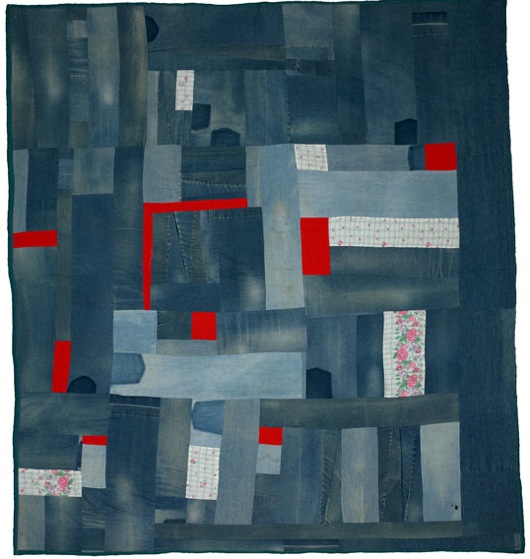
Moving back towards the east again, another example of this renewal can be found in the quilts of Yoshiko Jinzenji, a Japanese artist and master quilter who moves between her homes in Japan and Bali. What’s interesting about Yoshiko’s quilts is not only that they are incredibly intricate and beautiful, but that they seem quite organic and ‘pure’ on the surface, utilising her own hand dyed fabrics, but yet they incorporate the very un-traditional usage of synthetics and machine sewing.
 She uses those materials around her in order to be reborn in new creations.
She uses those materials around her in order to be reborn in new creations.
I know that quilting can sometimes seem old fashioned and stuffy, but I love that looking at examples of what others are doing around the world can reveal that actually, it's quite possible to turn tradition into something new, to improvise and use materials that are unusual and unexpected and to create original pieces of art that are both functional and beautiful. There are so many examples of people both locally and around the world making refreshing quilts. Have a search, be inspired, and why not try some yourself...
Joanna Francis spends most of her time hanging out with her 18 month old son. But she also works for a children’s foundation and has recently started her own little business making baby quilts. It goes without saying that her house is a mess. In the past, Joanna has worked as an aid worker in several developing countries, and is passionate about the rights of women and children. You can visit her and her blog at www.miettehandmade.com
Scenes From Sydney: Your Creative Process
By Jaclyn Carlson This month I've been focusing a lot on creativity, more specifically the creative process and how a simple idea or thought can blossom into something bigger than we ever imagined. For years I thought that in order to express yourself creatively you had to be a painter or an artist, something or someone visual, which admittedly I'm not. I've always been stronger with words and ideas so to finally understand the creative process and how it can relate to someone like myself was a real breakthrough.
The process itself is hard to define and is of course, different for everyone. For me, my best ideas come to me when I'm on the move and have time to think. Suddenly an idea will burst into my head for a blog post or craft project and I'll have to quickly try and capture those thoughts before I'm distracted and they've disappeared. To see these ideas through to fulfillment is so satisfying and to truly experience an amazing look at the creative process I highly recommend listening to Elizabeth Gilbert's TED Talk.
Sydney itself is bursting with creative women who understand and have mastered the creative process far better than I. That is exactly why I wanted to introduce Julia Denes, a Sydney based Jeweller, Designer, Gemmologist, Diamond Grader, and trained artist. After years spent working for some of Australia's top jewellers, in 2010 Julia launched her own business - Julia Denes Jewellery, giving her the creative freedom she'd always desired. As someone with such a dedicated art background I was curious about Julia's creative process and what I might be able to learn from her...
"My creative process usually begins with an overseas trip to a country that my heart has decided on. So far I’ve created ranges inspired by travels through South East Asia, Costa Rica, and Paris. Whilst away I spend weeks travelling around taking lots of photos of everything and anything that inspires me, from carvings and architecture to people and prominent places. I have a note pad with me at all times so I don’t forget a thing. This is the sketching and ideas process. On my return, I go through all of my photos and I’ll refine my sketches and choose the top 12-15 pieces. I then decide on the best and most fitting material to make the pieces from. I make each piece by hand so the making process generally takes the longest. From time of ordering the gold, silver or materials to making each piece, to setting the stones and then lastly polishing, it might be 2 months till the range is complete, especially if there is a design that needs to be revised a few times before it’s ready. I’m also a complete perfectionist which probably doesn’t help!"
Looking at her jewellery it is easy to see the love and passion she puts into her work however what really struck me was where her process started - travel, life experiences, moments. These are things that all of us can use to gain inspiration, to embrace our creativity and discover our own creative process.
Originally from Boston, Massachusetts, Jaclyn Carlson is the author behind the Sydney-based blog, Little Paper Trees. When not documenting her expat adventures, she can be found working for one of Australia’s top design & homewares trade shows. Passionate and prone to wasting hours on Pinterest, she has years of experience in marketing, advertising and PR and aims to put Sydney’s creative women in the spotlight with her monthly column
Tools of the Trade - Mischa Merz
By Brianna Read
This month Tools of the Trade has taken yet another welcome digression from the material toolkit. I had the pleasure of speaking with a woman named Mischa Merz and if you have heard this name before it could be for many reasons. Mischa is an accomplished painter, a journalist since the 1980’s, a writer and a boxer. You read correctly and now probably understand why I was quite excited to interview Mischa about the tools of her trade.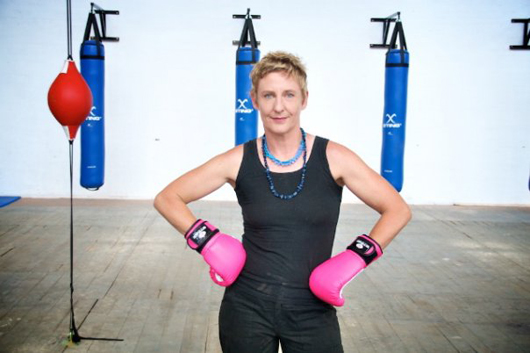
I cannot help but try to anticipate the tool each creative may list as their ‘must have’ – but I kept drawing a blank when I tried to pick this one.
Mischa’s writing practice started in newspapers, first local, then she moved on to The Herald (since merged with The Sun) and The Age as a freelancer and sometime sub-editor. You can still chance upon her journalism work in The Age from time to time but she has since allowed her writing for press to take a back seat in favour of her boxing training.
Mischa first came upon boxing when she undertook post-graduate studies in creative writing at the University of Melbourne. This change of pace coincided with a desire to get fit; enter the on campus box-a-cise classes.
Given that Mischa is this month launching her second book on the subject of boxing, it becomes apparent that this period in her life was the beginning of a seemingly unlikely union: writing and boxing. By this stage she was quite taken in by boxing and when she garnered the attention of publishing house Picador with an idea to write about her journey into amateur boxing it appears the marriage was cemented. Mischa mentions that at the time of her writing the first book (Bruising, 2000) it was quite against the grain to write about yourself, unlike current literary trends ‘Memoirs were not the done thing in this industry.”
So, you ask, what is the incredible tool Mischa cannot live without? Is the pen mightier than the fist? In fact, I think this may just be my favourite tool yet, it is that quality that children have in abundance and somewhere along the way most adults lose a little or all of it. It is none other than the willingness to take a risk and make mistakes!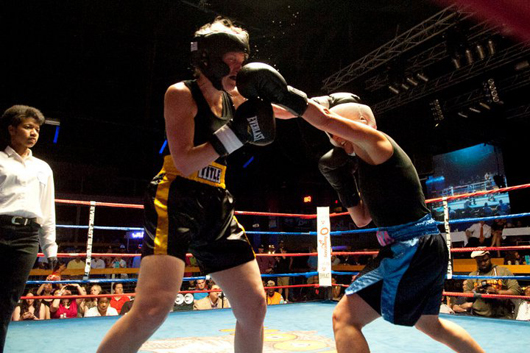
Mischa says that it was “naïve audacity” that got her into boxing, she admits she was not a particularly athletic person before boxing and had no idea how difficult the sport was. Initially she was “captivated by the concentration levels required, then became hooked on the complex theoretical base.” Contrary to popular belief boxing is not a sport for brutes, the exhilarating mix of dance and highly technical athleticism makes this the sport for anyone who loves moving and thinking.
The second book titled The Sweetest Thing is being launched next week at The Bella Union. This promises to be a book launch to buck all trends! The book itself is an entertaining account of Mischa’s journey to the US to compete in a series of amateur boxing tournaments. In my opinion this stands as a wonderful testimonial to where a willingness to take a risk can lead you.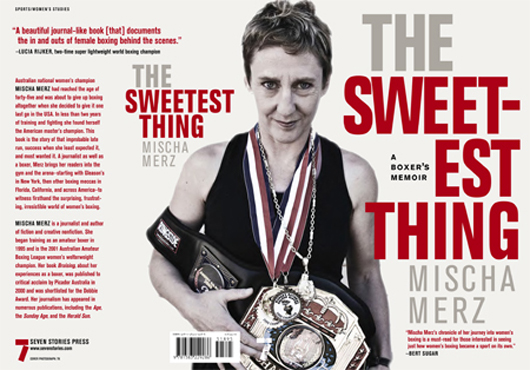
Mischa Merz runs boxing training classes at Crosse Training in Kensington and her website provides information on her many and varied talents.
Brianna Read is a designer/maker based in Melbourne. Her knitwear label Jack of Diamonds employs traditional hand-made techniques in combination with machine knit technologies. Brianna’s multi-faceted creative practice encompasses design, production, works for exhibition and machine knitting workshops.

